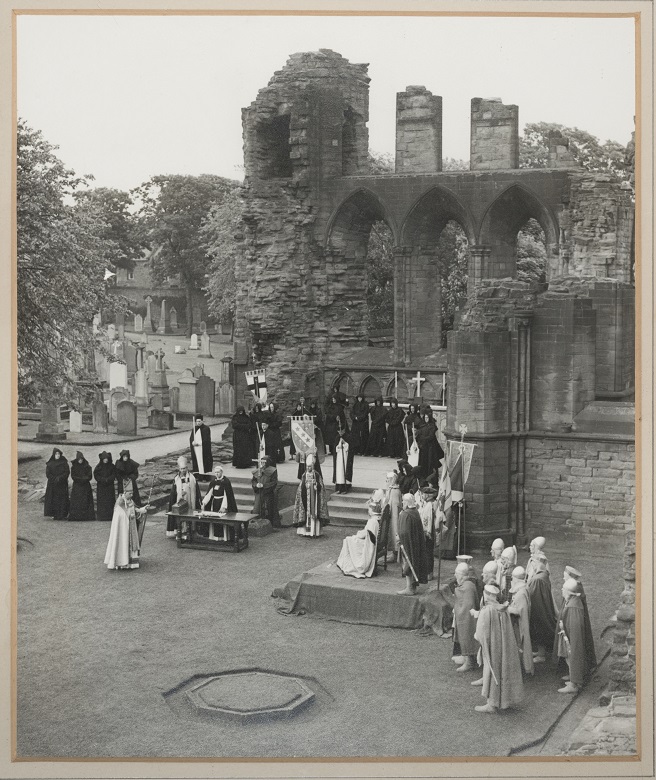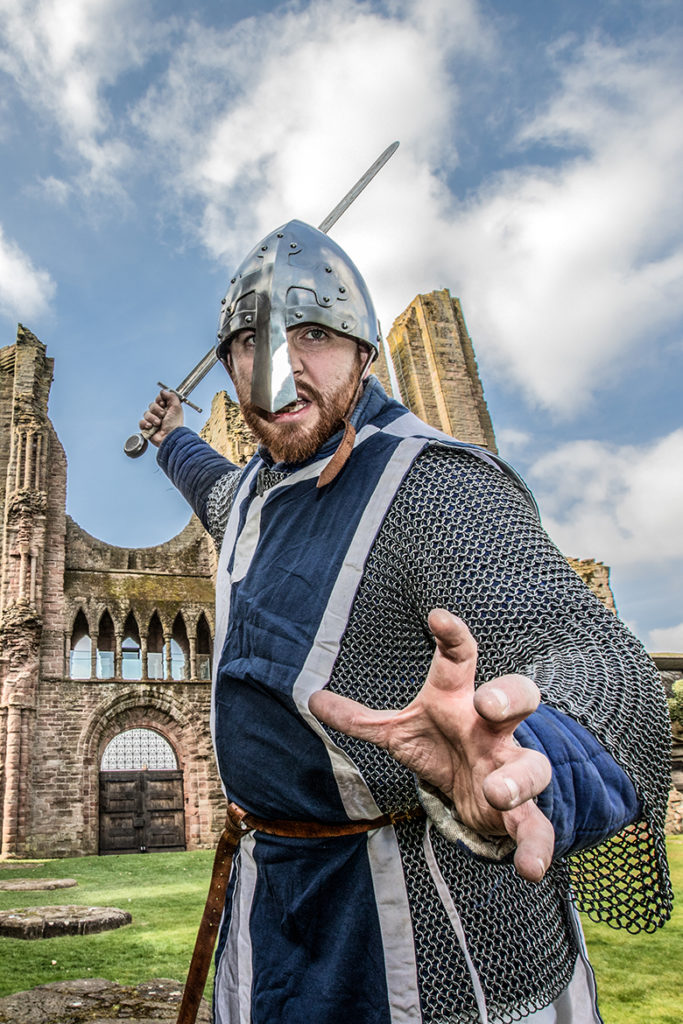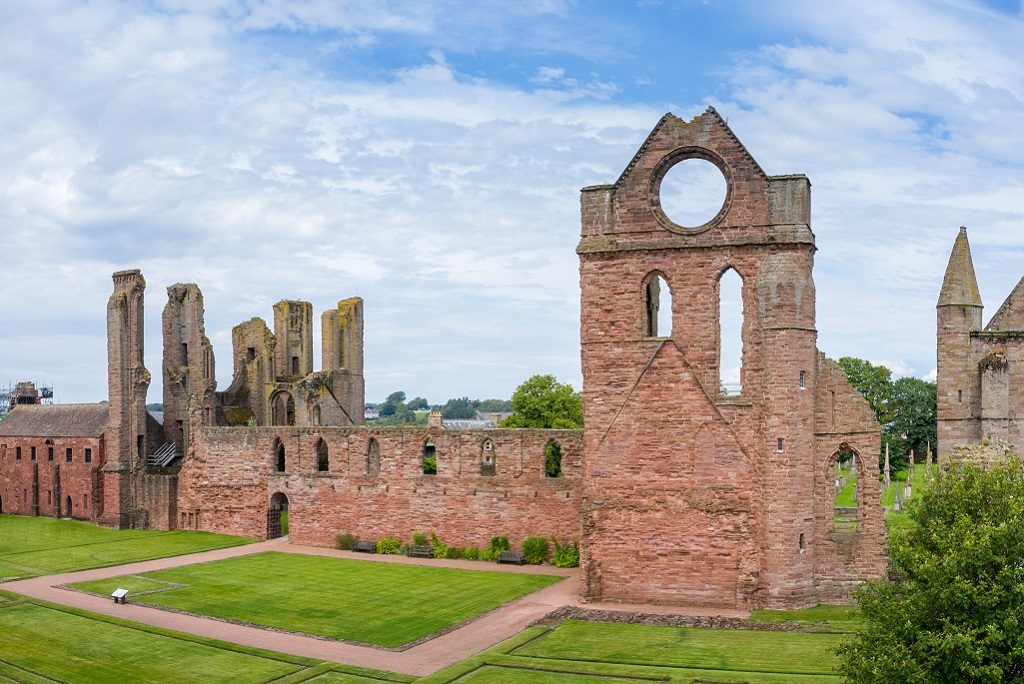Today, 6 April, marks the anniversary of the Declaration of Arbroath. Considering its lasting popularity, this document had a relatively unassuming start. It was one of three letters sent to the Pope during the reign of King Robert I (Robert the Bruce). The letters were an attempt to reverse the excommunication of Bruce from the Catholic church and to have King Edward II of England recognise Robert as the true king of Scotland. This was relatively unsuccessful, but the document has slowly gained fame over the past 700 years due to the stirring language used within it. You can find more about the story of this document in this blog by Andrew Burnett.
In honour of the anniversary today, let’s take a look at how the Declaration has been commemorated in the past.

Marking the big milestones
There have long been celebrations at Arbroath Abbey on or around the date of the anniversary. For example, for the 600th anniversary in 1920 there were speeches, a show by local children and a lunch. There was also a commemorative book produced. It was a relatively simple affair. Following the First World War everyone was conscious of not appearing to spend too much public money.
The 650th anniversary celebrations in 1970 were a larger production. There was a commemorative Post Office stamp circulated. The Declaration was put on public display and the Scottish Record Office produced a facsimile (copy) to be kept at Arbroath Abbey. The Scottish Education Department sent out a leaflet to all education authorities in Scotland that explained the importance of the document and offered some suggestions for teaching materials that could be used. Perhaps most notably, the Arbroath Pageant was put on for the first time in four years.
The Pageant
The now famous pageant began in 1947, and it originally took place each August for ten years. Initially it was to raise money for the YMCA to provide services for troops who were still abroad. Overall it has been performed eighteen times, including to celebrate the 650th anniversary, as well as to mark other important moments in Arbroath’s history, including the 400th anniversary of the borough charter in 1999.
The pageant has been updated over the years though the general format is largely the same: there is a prologue written by a local poet, an excerpt from a play telling the life story of Sir William Wallace, and then a scene portraying the signing of the Declaration. On average about 200 performers and crew are involved in each production, plus up to twenty-five horses. Grandstands would be built with up to 1,000 audience members watching each performance. The pageant has always been staged within the Abbey ruins and has taken place both day and night, with performances in 1999, 2000 and 2005 using cutting edge lighting systems to add to the immersive experience. It was often part of a wider series of events, such as in 1950 when there was a week-long programme including a ceilidh, a parade, and a thanksgiving service.

A re-enactment of the Declaration of Arbroath performed by the Arbroath Pageant Society.
Though the pageant has not been fully staged since 2005, the Arbroath Abbey Pageant Society has presented the Declaration scene at the Abbey on the 6 April to mark the anniversary nearly every year.
Tartan Day
More recently the anniversary of the Declaration on 6 April has been marked by Tartan Day celebrations. The date of 6 April was chosen for this annual celebration of Scottish culture over other holidays such as Burns Night or St Andrew’s Day. It began in the mid-1980s in Canada but is now most widely celebrated in America. In 1998, it was even made a national holiday in America. Today it is also celebrated in Australia, New Zealand, Argentina and even Scotland!
The celebrations in America have grown so large it is now known as Tartan Week. This culminates in a parade in New York. Past Grand Marshalls of the parade have included Brian Cox, Sean Connery, and Alan Cumming.
700th Anniversary
For the 700th anniversary in 2020, there was an array of both local and national celebrations planned. This included a community procession, a new exhibition at the Abbey and a celebration by the Arbroath Abbey Pageant Society. However, due to the Coronavirus pandemic, those celebrations became a digital-only affair.
But good things come to those who wait! The 701st anniversary, or “Arbroath 2020+1” will be celebrated with a reshaped festival combining online and physical events.
And what’s more, in August 2021, we unveiled another chapter in the commemoration of the Declaration. Our brand-new exhibition in the newly-refurbished visitor centre at Arbroath Abbey tells the story of the abbey since its foundation.
Among the 50+ amazing artefacts you can see the new Arbroath Tapestry, handmade by local embroiderers to celebrate the Declaration’s 700th anniversary and a new facsimile of the surviving Declaration of Arbroath created by the internationally renowned craftsman, David Frank.

In 2017, we commemorated the anniversary of the Declaration of Arbroath with the ‘For Freedom Alone’ event at Arbroath Abbey.
Find out more
If you’d like to find out more about the history of Declaration celebrations, here are some resources I’d recommend:
- J.N. Graham Ritchie’s essay ‘Images of the Declaration: The Arbroath Pageant’. You can read this in ‘Declaration of Arbroath: History, Significance, Setting’, edited by G.W.S Barrow.
- The Historical Pageants website. This is a really interesting resource full of all things related to historical pageants in Britain.
- In 2017, I wrote an article for the journal Scottish Affairs. It’s behind a paywall, but here’s the link if you’re keen to have a look: ‘That Famous Manifesto’.

